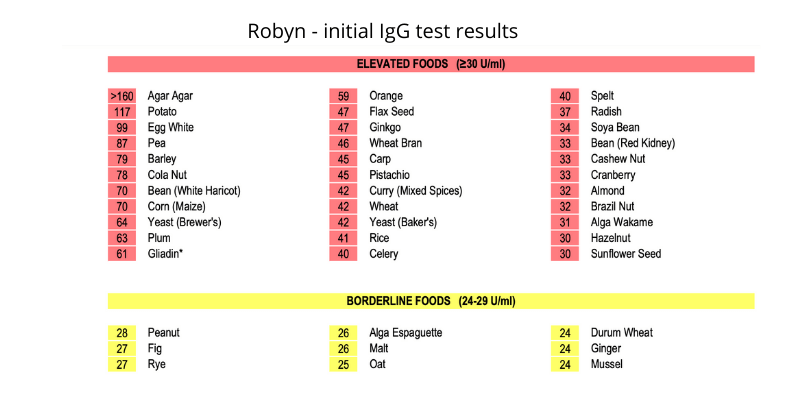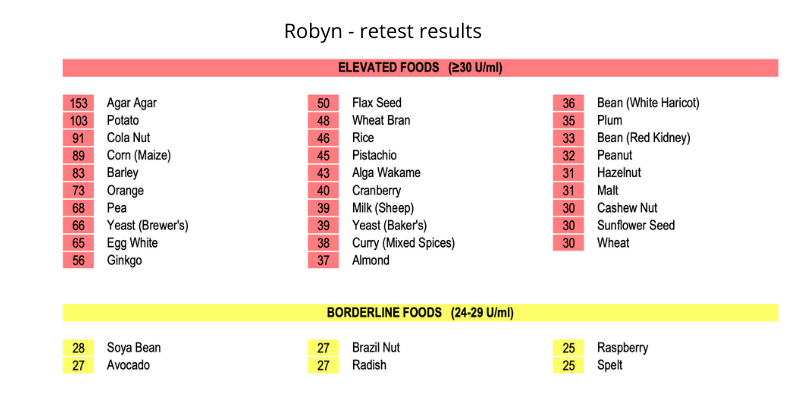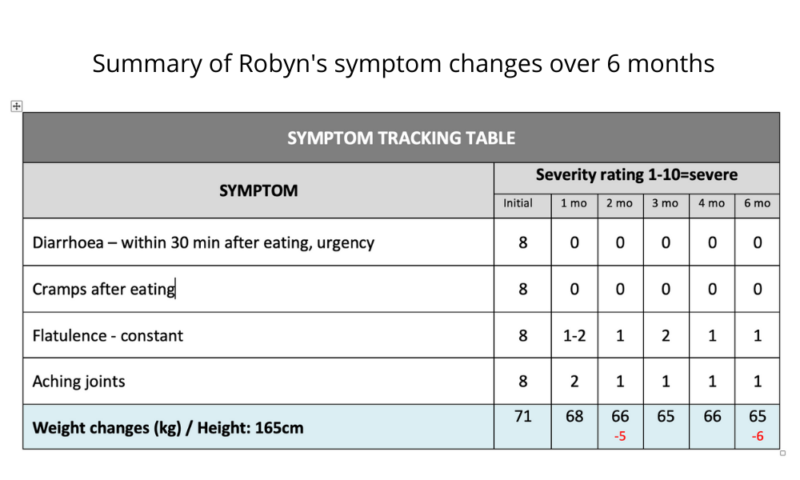What are the best foods to improve gut health? I get asked this question every day.
The honest answer is: it depends. What constitutes a healthy gut diet is different for every person and is a reflection of their nutrition intake, lifestyle choices and the environment.
How to find out which foods are best for you to improve gut health? One of the most effective methods is to identify and address food sensitivities you may have. Food intolerance testing is a reliable, safe and effective method to identify both the problematic and beneficial foods for optimal gut health.
In this post, I discuss a wonderful clinical case of resolving a number of severe gut symptoms following the IgG food sensitivities test and implementing an elimination diet based on the test results.
This type of testing utilises an ELISA (enzyme-linked immunosorbant assay) testing for IgG-mediated food sensitivities, called IgG FoodPrint®.
Find out more about the IgG food sensitivity testing and the methodology used in our clinical study utilising the elimination diet based on food sensitivity testing.
Our clinical study on applications of food sensitivity testing shows that the elimination diet can be a safe and effective method to significantly decrease gut inflammation (and inflammation throughout the body), improve digestion and elimination, decrease leaky gut, and calm down the immune system.
These positive changes support and speed up the healing processes in the vast majority of our clients involved in the clinical study. You can review all the case studies to date HERE.
How to resolve diarrhoea, flatulence, gut cramps eating the right foods – a case study
Clinical case presentation
Robyn is a 68-year-old retired teacher with two adult children. In the past, she was an accomplished athlete having represented Australia in Masters Dragon Boat racing.
She enjoys gardening and growing her own food, socialising with her friends, walking in nature, paddling and looking after her dogs. Unfortunately, her gut health deteriorated over the last 3 years severely impacting her life resulting in ‘needing to be within running distance of a toilet at all times’.
She said it was very embarrassing and stressful, and negatively impacted her social life – ‘trust me, I knew where every public toilet was at all times’.
Prior to her significant gut symptoms starting around 2 years ago, she was healthy and active, enjoyed exercising and retirement. This changed when she began experiencing symptoms of an unhealthy gut that impacted her ability to exercise and enjoy her social life.
At the initial consultation, she listed following main symptoms:
- Constant gut issues. Always uncomfortable but really bad at present
- Severe diarrhoea with urgency multiple times per day, usually within 30 minutes after eating, significantly impacting all aspects of her daily life
- Stomach pains and cramps after eating
- Constant flatulence
- Constipation – on/off
- Aching joints – getting worse
- Overweight – her weight was 71kg. Robyn wanted to lose around 6-7 kg
Her aim was to improve gut health naturally utilising nutrition and lifestyle adjustments, if possible, and minimise/ avoid supplements all together.
Robyn’s initial IgG food sensitivity test results
- High sensitivity ‘red’ foods: 33
- Borderline sensitivity ‘yellow’ foods: 9
Main foods/ food groups that needed to be excluded based on the IgG test results were:
- Gluten – high sensitivity to all gluten containing grains and products made of them
- Eggs – egg whites
- Yeast – both types of yeast, Brewer’s and baker yeast
- Nuts (7) – sensitivity to a large number of nuts
- Corn and soy
- Other: potato, orange, rice, celery, sunflower seeds (oil)
See the initial IgG food sensitivities test summary of the most intolerant foods below:

Progress timeline
I regularly consulted with Robyn every 4 weeks for 7 months to guide her through the program. The aims were to help her better understand the food restrictions, provide nutrition advice and meal suggestions, remove obstacles and monitor symptoms/ progress.
Consultation #1: 1 month after starting the elimination diet
Robyn eliminated all ‘red’ and ‘yellow’ foods from the start (see the above table). The most challenging for her was to eliminate gluten and foods containing it as well as rice. However, she did manage it to do it just fine by having gluten free grains such as buckwheat, millet and tapioca instead.
She was strictly adhering to the elimination diet and her results after just one month on the elimination diet were remarkable:
- Complete resolution of diarrhoea – from 8/10 to 0/10 (10=severe)
- No/minimal cramps after eating – from 8/10 to 1/10
- Markedly decreased flatulence – from 8/10 to 2/10
- Significant decreased pain in the joints – from 8/10 to 2/10
- Weight loss – 3 kg
She was eating foods that were on the ‘green’ list (i.e. not causing inflammation) and found plenty of choices that she knew improve gut health daily. As always, we discussed adding more variety to her diet to make sure she ate a balanced diet. This included delicious recipes and food preparation tips, as well as a sufficient rotation of foods to prevent developing further food intolerances.
Overall, she reported doing very well and said she couldn’t believe what a remarkable difference the diet made to her life within such a short period of time.
Robyn was very diligent when eating out to avoid the ‘red’ foods, and sometimes she ate a small meal before going out to avoid problematic ingredients. She mostly stopped buying take away foods as they likely contained ‘unsafe’ ingredients.
Consultation #2: 2 months on the elimination diet
Robyn was eating mainly organic foods and grew her own produce as much as possible. She started to make sauerkraut to improve the microbiome composition which is a very good strategy to improve gut health. Robyn said it was fun cooking new meals and she was very motivated to eat well only including the ‘green’ foods from her food sensitivities test. At this stage, she decided to give up bread all together.
Overall, she was doing very well and said was now as she was now able to enjoy her life much more. She got off all pain killers she was taking for aching joints as the inflammation levels were decreased significantly by removing trigger foods.
She continued to improve with all symptoms as follows:
- Diarrhoea – completely resolved from 8/10 to 0/10
- Cramps after eating – completely resolved from 8/10 to 0/10
- Flatulence – significantly improved from 8/10 to 1/10
- Aching joints – significantly improved from 8/10 to 1/10
- Weight loss past month: 2kg. Overall weight loss:: 5kg
Consultations #3 to #6 months on the elimination diet
Robyn continued to follow the elimination diet close to 100% avoiding the ‘red’ and ‘yellow’ foods. She maintained all significant improvements as mentioned in previous consultation summaries, see the above.
She became skilled and knowledgeable in choosing the right foods for her, and cooking her meals at home using organic produce from her garden.
Robyn experimented with making her own sourdough bread and reintroduced organic oats without any gut problems. She said that before the test she was bit of a ‘lazy cook’ but having learnt new methods of food preparation, nutrient content of foods and new recipes, she felt motivated and had fun trying new things.
She went away to visit her son for a few weeks and enjoyed being able to go for walks and doing many other activities without worrying about having any urgent diarrhoea attacks.
Her energy levels and stamina were very good. During the 6 months following the elimination diet, she lost 6kg and achieved her ideal weight of 65kg without restricting portion sizes or calories. The body let go of the excess weight naturally and effortlessly. We see this happening in the majority of clients undertaking the elimination diet based on the IgG food testing.
Two out of the four main gut symptoms i.e. urgent diarrhoea and stomach pains were resolved 100%. The other two (i.e. stomach cramps and joint pain) decreased by 90%. Her goal to improve gut health and overall health was achieved.
Consultation #7: IgG food sensitivities retest at 7 months on the diet
- High sensitivity ‘red’ foods: 29 (down from 33 initially)
- Borderline yellow foods: 6 (down from 9 initially)

There was a modest improvement in a number of food sensitivities on the retest, apart from a very important one: her gluten intolerance lessened significantly. Remaining on the’ red’ list were wheat and barley but she could now reintroduce oat, rye and spelt (occasionally).
Notably, the aim of retesting is not to record zero food intolerances on retest. These are present all the time and their numbers fluctuate depending on the diet, stress load, environmental triggers etc.
The retest also showed that Robyn’s sensitivities to rice, potato and egg white and nuts need more time to resolve or decrease.
She decided to keep following the elimination diet based on the retest results and add a few foods that were ‘corrected’ during the 6 months. This eating plan is easy for her to follow and as long as she doesn’t overindulge, she is able to eat many more foods than before.
Symptom tracking table in chronological order showing Robyn’s progress

Summary
Robyn was very happy with the results of following the elimination diet for 6 months. She estimated her overall improvement of symptoms at a remarkable 90%. She also lost 6kg and achieved her desired weight.
Initially, it was quite a challenge for her to adjust to the new eating patterns but when the symptoms quickly lessened after the first month on the diet, her enthusiasm for the program increased and remained high for the duration.
She diligently sent the food diaries to me every month for us to check and tweak any area that needed attention. This also helped to make sure Robyn ate a good variety of foods and rotated them adequately.
Overall, Robyn is almost symptom free at present and resumed her social life with confidence. She stated: ‘ life is my own again to enjoy’!
Read Robyn’s story in her own words HERE.
Read the fully referenced clinical study HERE.
If you’ve been inspired by Robyn’s health journey, give me a call! I’d love to hear your story and what health challenges you are dealing with.
Feel free to get in touch with me to discuss your circumstances and how correcting food intolerance might help you overcome your health challenges. I’m an online Nutritionist and Naturopath based in Sydney but consulting Australia-wide via Zoom or telephone.
Book an online consultation now or click on the button below to book a free 25-minute initial discussion to talk about your circumstances and how I can help.
I look forward to helping you get better health and wellbeing soon!
Good health and blessings
Joanna Sochan
Wholistic Health and Lifestyle Therapist
Natural and Lifestyle Therapies for Abundant Health and Wellbeing
Additional resources
- Optimal healthy gut diet – a case study
- Weight loss and food sensitivities – Karen’s story
- Test: Food sensitivity test (IgG test)
- What is leaky gut? Causes, symptoms, remedies
Disclaimer: The above material is for informational and educational purposes only. It should not be used to self-diagnose and it is not a substitute for a medical advice, diagnosis, treatment, prescription or recommendation. All viewers of this content, especially those taking prescription or over-the-counter medications, should not make any changes in their health regimen or diet before first consulting a doctor or other qualified health provider with any questions they may have regarding a medical condition or their particular circumstances.
 Joanna Sochan is a Natural Therapist and founder of Naturimedica Holistic Wellcare. She has a passion for helping clients transform their lives by becoming healthy and well naturally. Joanna has 12+ years experience in clinical practice and has special interest in solving complex cases, gut health, food sensitivities, hormone imbalances, autoimmune disorders and weight loss. She helps clients individually (mostly online) Australia-wide and also offers online therapeutic programs, eCourses and self-help eBooks. View full bio.
Joanna Sochan is a Natural Therapist and founder of Naturimedica Holistic Wellcare. She has a passion for helping clients transform their lives by becoming healthy and well naturally. Joanna has 12+ years experience in clinical practice and has special interest in solving complex cases, gut health, food sensitivities, hormone imbalances, autoimmune disorders and weight loss. She helps clients individually (mostly online) Australia-wide and also offers online therapeutic programs, eCourses and self-help eBooks. View full bio.
 Print This Post
Print This Post 


Leave A Comment